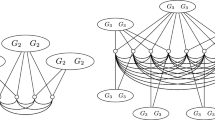Abstract
A graph property is a set of graphs such that if the set contains some graphG then it also contains each isomorphic copy ofG (with the same vertex set). A graph propertyP onn vertices is said to be elusive, if every decision tree algorithm recognizingP must examine alln(n−1)/2, pairs of vertices in the worst case. Karp conjectured that every nontrivial monotone graph property is elusive. In this paper, this conjecture is proved for some cases. Especially, it is shown that if the abstract simplicial complex of a nontrivial monotone graph propertyP has dimension not exceeding 5, thenP is elusive.
Similar content being viewed by others
References
Rosenberg A L. On the time required to recognize properties of graphs: A problem.SIGACT News, 1973, 5(1): 15–16.
Kahn J, Saks M, Strutevant D. A topological approach to evasiveness.Combinatorica, 1984, 4(2): 297–306.
Bollobas B. Complete subgraphs are elusive.J. Combinatorial Theory (Ser. B), 1976, 21(2): 1–7.
Kirkpatrick D. Determining graph properties from matrix representations. InProceedings of 6th SIGACT Conference, Seattle 1974,ACM, 1975, pp.84–90.
Milner E C, Welsh D J A. On the computational complexity of graph theoretical properties. InProceedings of 5th British Columbia Conf. Combinatorics, 1975, pp.471–487.
Triesch E. Some results on elusive graph properties.SIAM J. Computing, 1994, 23(1): 247–254.
Du D-Z. Decision Tree Theory. Kluwer Academic Publishers, Boston, 1996.
Bollobas B, Eldridge S E. Problem. InProceedings of Fifth British Combinatorial Conf., Utilitas Math., Winnipeg, C. st. J. A. Nash-Williams, Sheehan J (eds.), 1976, pp. 689–691.
Author information
Authors and Affiliations
Corresponding author
Additional information
GAO Suixiang received his Ph.D. degree in 1998 from the Institute of Applied Mathematics, Chinese Academy of Sciences. Now, he is a postdoctor in the Graduate School, the University of Science and Technology of China. His research interests include decision tree complexity theory, design and analysis of algorithm design and analysis of interconnection network, graph theory and its application, network flow theory, and communication network optimization.
LIN Guohui received his Ph.D. degree in computer science in 1997 from the Institute of Applied Mathematics, Chinese Academy of Sciences. He was a postdoctor at the Department of Computer Science, University of Vermont. Now, he is a postdoctoral fellow at the Department of Computer Science, University of Waterloo, and the Department of Computing and Software, McMaster University. His research interests include design and analysis of algorithms, design and analysis of switching networks, global routing and time-driven routing in VLSI physical design, computational geometry and computational molecular biology.
Rights and permissions
About this article
Cite this article
Gao, S., Lin, G. Decision tree complexity of graph properties with dimension at most 5. J. Comput. Sci. & Technol. 15, 416–422 (2000). https://doi.org/10.1007/BF02950404
Received:
Revised:
Issue Date:
DOI: https://doi.org/10.1007/BF02950404




